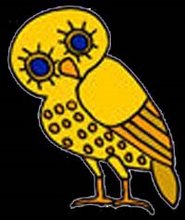 The Dragonflies of Lesvos
The Dragonflies of Lesvosby John Bowers
Published 2008
ISBN 978-960-930703-1
The Friends of Lesbos / http://www.greenlesbos.com/
£19.99 from UK retailers (or €15 from Green Lesbos in Skala Polichnitou when on the island).
Available from Friends of Lesbos. All profits are donated to Friends of Lesbos.
Dragonflies are a much loved group of birdwatchers, myself included. They occur in many of the habitats birdwatchers visit so get noticed. In recent years there has been an avalanche of new dragonfly books covering both Britain (including my own Watching British Dragonflies) and Europe (including the excellent Field Guide to the Dragonflies of Britain and Europe, Dijkstra, K-D B & Lewington, R. 2006).
As a dragonfly enthusiast I have found dragonfly watching on Lesvos somewhat frustrating. This is mostly my own fault as my trips tend to be focussed on guiding birdwatchers around the island at times not ideal for observing dragonflies (i.e. before many species are on the wing!) and there is only limited scope on a birding week to spend watching other wildlife!
What is surprising about Lesvos dragonflies is that so many species occur on what is essentially a pretty dry island. Many of the species present are true dry area species which have developed to take advantage of seasonal freshwater areas. As most dragonfly watchers know, water is needed largely to oviposit eggs, with most of an adult dragonfly’s life spent away from water feeding and roosting. Few species rely on water bodies for food.
The Dragonflies of Lesbos is a much needed guide to the species found on the island. It is essentially a privately published work and the sole project of the author. The 92-page guide is slim in format (220mm x 112mm) and is made up of six chapters: what are dragonflies; dragonfly habitats; some dragonfly sites; identification of dragonflies; a guide to identifying dragonflies on Lesvos; and the conservation of dragonflies [on Lesvos]. A single appendix lists the species recorded on Lesvos. In addition there are 26 photographic plates including 17 depicting 45 species.
The author has visited the island on numerous occasions and has also drawn heavily on Wolfgang Lopau’s (German biologist) knowledge of the island’s odonata as well as his excellent “Die Libellenfauna der Insel Lesbos” (The dragonfly fauna of the island of Lesbos) (Lopau, W. 1995. Naturkundliche Reiseberichte (Heft 3). Gnarrenburg 1995) from which the list of species for the island in the books appendix is produced.
 Odalisque, Achladeri, Lesvos, Apr 2002 © Steve Dudley
Odalisque, Achladeri, Lesvos, Apr 2002 © Steve Dudley
The most useful aspect of this guide will be to point observers in the right direction to see individual species on the island. Some species are easily seen when wandering around, but for others, specific site information is a real bonus. The site guide section (14 pages) is excellent. No detailed maps are provided but there is enough in the text to help you get by and locate many of the sites (and latitude and longitude coordinates will assist those with a GPS or you can enter them into Google Earth to produce your own maps before you travel – note that the available maps for the island lack coordinates so will be of no use in this respect). The one map produced I presume is meant to have the site numbers detailed on it, but these are missing so it is rendered useless. Species for each site are also given. There is a useful table listing each site and what species occur in late May and late September. Whilst useful, most birdwatchers visit in the first half of May so many species may not be on the wing during their stay. The details on habitats and flight periods within the individual species accounts is also very useful as both of these can vary for insects on small islands from information given in more mainstream or general European guides.
The photographic plates should in no way be used as a sole means of reference for field identification. This should be achieved using the Field Guide to the Dragonflies of Britain and Europe. The photographs are useful in depicting different species but vary in overall quality (in both the taken image and reproduction). Some photos are excellent but others are very poor and would have been better omitted.
Whilst this is a very useful book, it is however a hugely frustrating one to access and read. This is due largely to the fact that the book has been produced by a single individual who’s primary interest appears to be dragonflies (I’d say an odonatist more than simply a dragonfly watcher) and a small society with no or little publishing experience (I speak here as publisher).
Firstly the layout is rather amateurish and could have been significantly improved by a good designer (critical for a successful field guide in my opinion). Secondly there is no index, no page numbers listed in the contents page and little use of page references used throughout the book. Plate references are often given in the text, but fail to give page numbers so you have to leaf back and forth searching.
The biggest failure however is the lack of English species name. Only scientific names are used throughout (including in the only list of species for the island) and I find this totally perplexing in this day and age. How does the author/publisher expect to engage the reader/user by only using scientific names which are alien to all but biologically trained individuals? There is no excuse since the Field Guide to the Dragonflies of Britain and Europe established very usable English names for all the species covered by this title. As an experienced dragonfly observer I know many scientific species names, but not all those covered by this book. I’ve long stopped using scientific names in Britain and since the publication of the Field Guide to the Dragonflies of Britain and Europe have adopted the English names used in this title. I will go as far as to say that within the British birdwatching community there is a long standing impression of insect watchers being elitist and exclusionist to other groups of observers. English names are simply more accessible to the masses, they are better understood and remembered. It is easy to recall a small damselfly with a blue abdomen tip as a Blue-tailed damselfly rather than it is to remember Ischnura elegans. No, the lack of English species names means this title will remain the preserve of the few used to using scientific names. Birdwatchers and the general public will be seriously put off using it which is a real shame when this could have so easily been avoided.
If you can handle scientific names, or be prepared to muddle by (you can always write all the English names in from the Field Guide to the Dragonflies of Britain and Europe) and want to know more about the dragonflies of Lesvos, then this is the only book available. At £19.99 it will put some people off, but it can be purchased on the island for €15 (from Green Lesbos in Skala Polichnitou).
Steve Dudley
























